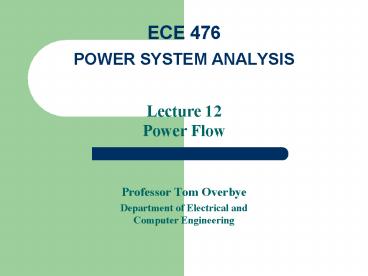Lecture 12 Power Flow - PowerPoint PPT Presentation
1 / 47
Title:
Lecture 12 Power Flow
Description:
Department of Electrical and. Computer Engineering. ECE 476. POWER SYSTEM ANALYSIS. 1 ... that bus one is the slack and SBase = 100 MVA. 31. Two Bus Example, ... – PowerPoint PPT presentation
Number of Views:1394
Avg rating:3.0/5.0
Title: Lecture 12 Power Flow
1
ECE 476POWER SYSTEM ANALYSIS
- Lecture 12Power Flow
- Professor Tom Overbye
- Department of Electrical andComputer Engineering
2
Announcements
- Homework 5 is due now
- Homework 6 is 2.38, 6.8, 6.23, 6.28 you should
do it before the exam but need not turn it in. - First exam is 10/9 in class closed book, closed
notes, one note sheet and calculators allowed - Abbott power plant and substation field trip,
Tuesday 10/14 starting at 1230pm. Well meet at
corner of Gregory and Oak streets. - Be reading Chapter 6 exam covers up through
Section 6.4 we do not explicitly cover 6.1.
3
Newton-Raphson Algorithm
- The second major power flow solution method is
the Newton-Raphson algorithm - Key idea behind Newton-Raphson is to use
sequential linearization
4
Newton-Raphson Method (scalar)
5
Newton-Raphson Method, contd
6
Newton-Raphson Example
7
Newton-Raphson Example, contd
8
Sequential Linear Approximations
At each iteration the N-R method uses a
linear approximation to determine the next
value for x
Function is f(x) x2 - 2 0. Solutions are
points where f(x) intersects f(x) 0 axis
9
Newton-Raphson Comments
- When close to the solution the error decreases
quite quickly -- method has quadratic convergence - f(x(v)) is known as the mismatch, which we would
like to drive to zero - Stopping criteria is when ?f(x(v)) ? lt ?
- Results are dependent upon the initial guess.
What if we had guessed x(0) 0, or x (0) -1? - A solutions region of attraction (ROA) is the
set of initial guesses that converge to the
particular solution. The ROA is often hard to
determine
10
Multi-Variable Newton-Raphson
11
Multi-Variable Case, contd
12
Multi-Variable Case, contd
13
Jacobian Matrix
14
Multi-Variable N-R Procedure
15
Multi-Variable Example
16
Multi-variable Example, contd
17
Multi-variable Example, contd
18
Power System Planning MISO
Source Midwest ISO MTEP08 Report
19
MISO Generation Queue
Source Midwest ISO MTEP08 Report
20
MISO Conceptual EHV Overlay
Black lines are DC, blue lines are 765kV, red are
500 kV
Source Midwest ISO MTEP08 Report
21
Illinois EHV Overlay
Source Midwest ISO MTEP08 Report
22
Transmission Siting Example
23
Madison Transmission Siting Example Lots of
Support and Opposition
24
NR Application to Power Flow
25
Real Power Balance Equations
26
Newton-Raphson Power Flow
27
Power Flow Variables
28
N-R Power Flow Solution
29
Power Flow Jacobian Matrix
30
Power Flow Jacobian Matrix, contd
31
Two Bus Newton-Raphson Example
For the two bus power system shown below, use the
Newton-Raphson power flow to determine the
voltage magnitude and angle at bus two.
Assume that bus one is the slack and SBase 100
MVA.
32
Two Bus Example, contd
33
Two Bus Example, contd
34
Two Bus Example, First Iteration
35
Two Bus Example, Next Iterations
36
Two Bus Solved Values
Once the voltage angle and magnitude at bus 2 are
known we can calculate all the other system
values, such as the line flows and the generator
reactive power output
37
Two Bus Case Low Voltage Solution
38
Low Voltage Solution, cont'd
Low voltage solution
39
Two Bus Region of Convergence
Slide shows the region of convergence for
different initial guesses of bus 2 angle (x-axis)
and magnitude (y-axis)
Red region converges to the high voltage
solution, while the yellow region converges to
the low voltage solution
40
PV Buses
- Since the voltage magnitude at PV buses is fixed
there is no need to explicitly include these
voltages in x or write the reactive power balance
equations - the reactive power output of the generator varies
to maintain the fixed terminal voltage (within
limits) - optionally these variations/equations can be
included by just writing the explicit voltage
constraint for the generator bus Vi Vi
setpoint 0
41
Three Bus PV Case Example
42
Modeling Voltage Dependent Load
43
Voltage Dependent Load Example
44
Voltage Dependent Load, cont'd
45
Voltage Dependent Load, cont'd
With constant impedance load the MW/Mvar load
at bus 2 varies with the square of the bus 2
voltage magnitude. This if the voltage level is
less than 1.0, the load is lower than 200/100
MW/Mvar
46
Solving Large Power Systems
- The most difficult computational task is
inverting the Jacobian matrix - inverting a full matrix is an order n3 operation,
meaning the amount of computation increases with
the cube of the size size - this amount of computation can be decreased
substantially by recognizing that since the Ybus
is a sparse matrix, the Jacobian is also a sparse
matrix - using sparse matrix methods results in a
computational order of about n1.5. - this is a substantial savings when solving
systems with tens of thousands of buses
47
Newton-Raphson Power Flow
- Advantages
- fast convergence as long as initial guess is
close to solution - large region of convergence
- Disadvantages
- each iteration takes much longer than a
Gauss-Seidel iteration - more complicated to code, particularly when
implementing sparse matrix algorithms - Newton-Raphson algorithm is very common in power
flow analysis































